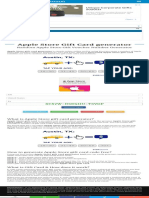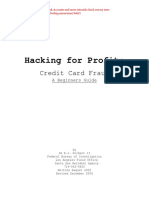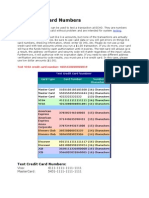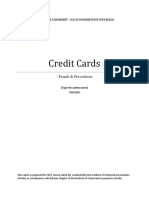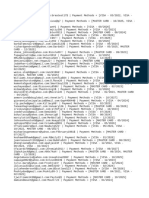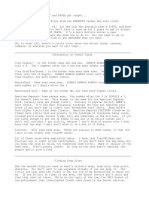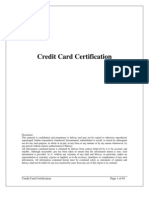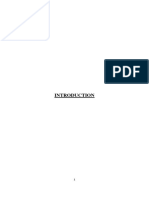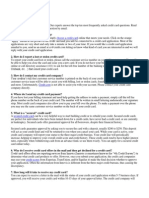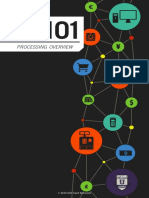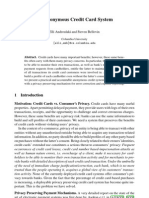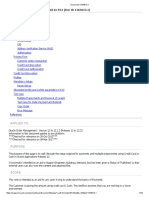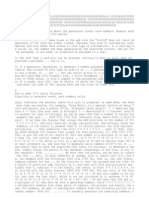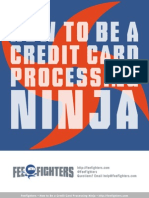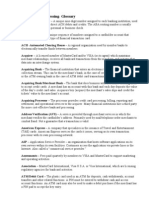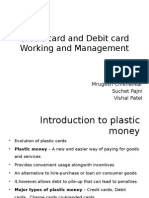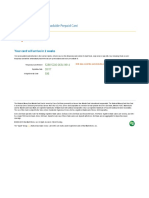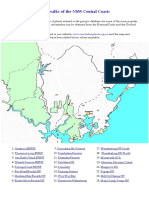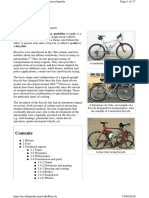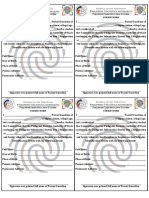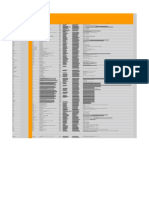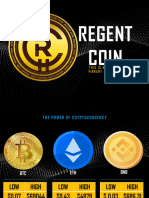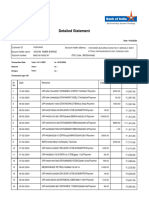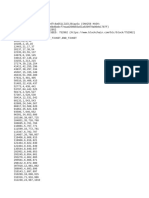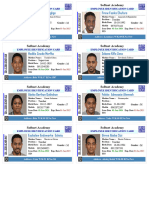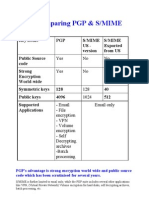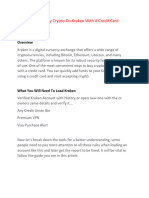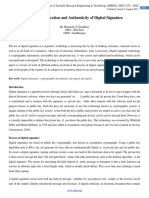Payment Card Number
Payment Card Number
Uploaded by
lunwenCopyright:
Available Formats
Payment Card Number
Payment Card Number
Uploaded by
lunwenOriginal Description:
Copyright
Available Formats
Share this document
Did you find this document useful?
Is this content inappropriate?
Copyright:
Available Formats
Payment Card Number
Payment Card Number
Uploaded by
lunwenCopyright:
Available Formats
Payment card number
A payment card number, or simply a card number, is
the card identier found on payment cards, such as credit
cards and debit cards, as well as stored-value cards, gift
cards and other similar cards. In some situations the card
number is referred to as a bank card number. The card
number is merely a card identier and does not identify
the account to which it is linked by the issuing company,
nor does it identify the cardholder. The card number
identies the issuer of the card, which is then electronically associated by the issuing organization with one of
its customers and then to the customers designated bank
accounts. In the case of stored-value type cards, there is Partial IIN on a credit card (both printed and embossed)
no necessary association with a particular customer. Card
numbers are allocated in accordance with ISO/IEC 7812.
The card number is usually prominently embossed on the
2 Issuer identication number
front of a payment card.
(IIN)
The payment card number diers from the Bank Identier Code (BIC/ISO 9362, a normalized codealso
known as Business Identier Code, Bank International
The rst six digits of a card number (including the initial
Code, and SWIFT code). It also diers from Universal
MII digit) are known as the issuer identication number
Payment Identication Code, another identier for a bank
(IIN). These identify the card issuing institution that isaccount in the United States.
sued the card to the card holder. The rest of the number
is allocated by the card issuer. The card numbers length
is its number of digits. Many card issuers print the entire
IIN and account number on their card.
1
Structure
In the United States, IINs are also used in NCPDP pharmacy claims to identify processors, and are printed on all
pharmacy insurance cards. IINs are the primary routing
The leading six digits of the card number is the "issuer mechanism for real-time claims.
identication number (IIN)", sometimes referred to as
the bank identication number (BIN)". The remaining The ISO Register of Issuer Identication Numbers
numbers on the card are referred to as the primary ac- database is managed by the American Bankers Associacount number or PAN. IINs and PANS have a certain tion. ABA is the Registration Authority for this standard
level of internal structure and share a common numbering and is responsible for allocating IINs to issuers.
scheme set by ISO/IEC 7812. Payment card numbers can Online merchants may use IIN lookups to help validate
be up to 19 digits, as follows:
transactions. For example, if a cards IIN indicates a bank
in one country, while the customers billing address is in
another, the transaction may call for extra scrutiny.
a six-digit[1] Issuer Identication Number (IIN), the On November 8, 2004, MasterCard and Diners Club
rst digit of which is the Major Industry Identier formed an alliance. Diners Club cards issued in Canada
(MII)
and the United States start with 54 or 55 and are treated
as MasterCards worldwide. International cards use the
36 prex and are treated as MasterCards in Canada and
a variable length (up to 12 digits) individual account the United States, but are treated as Diners Club cards
identier
elsewhere. Diners Club Internationals web site makes no
reference to old 38 prex numbers, and they can be presumed reissued under the 55 or 36 IIN prex. Eective
a single check digit calculated using the Luhn algo- October 16, 2009, Diners Club cards beginning with 30,
rithm[2]
36, 38 or 39 have been processed by Discover Card.[14]
1
On November 3, 2014, MasterCard announced that they
were introducing a new series of BIN ranges that begin
with a 2 (222100272099). The 2 series BINs will
be processed the same as the 5155 series BINs are
today. They will become active 14 October 2016.
On July 23, 2014 JSC NSPK was established in Russian
Federation. Joint Stock Company National System of
Payment Cards (NSPK) is the operator of Mir National
Payment System. The main initiatives of NSPK are to
create the national payment system infrastructure and to
issue a national payment card Mir.
Eective October 1, 2006, Discover began using the entire 65 prex, not just 650. Also, similar to the MasterCard/Diners agreement, China Union Pay cards are now
treated as Discover cards and accepted on the Discover
network.
Whilst the vast majority of Visas account ranges describe
16 digit card numbers there are still a few (40 as of 11
Dec. 2013) account ranges dedicated to 13 digit PANs
and several (439 as of 11 Dec. 2013) account ranges
where the issuer can mix 13 and 16 digit card numbers.
Visas VPay brand can specify PAN lengths from 13 to
19 digits and so card numbers of more than 16 digits are
now being seen.
Switch was re-branded as Maestro in mid-2007.[15] In
2011, UK Domestic Maestro (formerly Switch) was
aligned with the standard international Maestro proposition with the retention of a few residual country specic
rules.
EMV Certication requires acceptance of a 19-digit Visa
card (ADVT 6.1.1 Test Case 2) and Discover Card (E2E
Test Plan v1.3, Test Case 06).
2.1
Canadian bank card numbering
Bank card numbers issued by Canadian banks also follow
a pattern for their systems:
Security measures
To reduce the risk of credit card fraud, various techniques
are used to prevent the dissemination of bank card numbers. These include:
Format-preserving encryption: in which the account
number is replaced with a strongly encrypted version
which retains the format of the card data including
non sensitive parts of the eld such as rst six and
last four digits. This permits data eld protection
without changing payment IT systems and applications. A common use is for protecting card data
from the point of capture in a secure reader to the
payment processing host end-to-end to mitigate risk
of data compromise in systems such as the Point of
REFERENCES
Sale (POS). AES-FF1 Format-Preserving Encryption is dened in NIST Specication SP800-38G.
PAN truncation: in which only some of the digits on
a card are displayed or printed on receipts. The PCI
DSS standard dictates that only the rst six and last
four digits of the PAN may be printed on a receipt or
displayed in cases other than where a business need
requires the full PAN. US federal law (FACTA) allows only the display of the last 5 digits. In order
to comply with both PCI DSS requirements and US
federal law, generally only the last four digits are
provided elsewhere to allow an individual to identify the card used.
Tokenization: in which an articial account number
(token) is printed, stored or transmitted in place of
the true account number.
4 See also
Bank account
Carding (fraud)
Card security code
International Bank Account Number
Routing transit number
ISO 9362SWIFT Code or BIC Code
5 References
[1] What your credit card numbers mean. Retrieved 201012-07.
[2] ISO/IEC 7812-1:2006 Identication cards Identication of issuers Part 1: Numbering system
[3] Card Security Features (PDF). American Express. January 2001. Archived (PDF) from the original on 5 March
2006. Retrieved 2006-04-05.
[4] American Express Fraud Prevention Handbook (PDF).
p. 13. Retrieved 2006-04-05.
[5] Bankcard Association of Australia. Archived from the
original on 6 April 2006. Retrieved 2006-04-05.
[6] China UnionPay Cards. Retrieved 2016-02-08.
[7] MasterCard Diners Club Alliance. Retrieved 2006-0405.
[8] Discover Bulletin for VARs Feb 2015 (PDF). Retrieved
2015-08-14.
[9] Diners Club - Fraud Management. Retrieved 2007-0126.
[10] Discover Network - IIN Range Update, 8.2 (PDF).
September 2008. Retrieved 2008-10-23.
[11] Discover Network IIN Range Update, 9.2 (PDF).
September 2009.
[12] Laser Card Services Ltd.. 28 February 2009.
[13] Maestro Global Rules (PDF). MasterCard. 9 November
2012.
[14] Discover Network - IIN Range Update, 9.1 (PDF). October 2008. Retrieved 2009-01-28.
[15] Switch to Maestro. Archived from the original on 8 August 2010. Retrieved 2010-08-20.
External links
H.P. Luhn and Automatic Indexing
What your credit card numbers mean
7 TEXT AND IMAGE SOURCES, CONTRIBUTORS, AND LICENSES
Text and image sources, contributors, and licenses
7.1
Text
Payment card number Source: https://en.wikipedia.org/wiki/Payment_card_number?oldid=729479722 Contributors: Robert Merkel,
The Anome, Edward, Bdesham, Dreamword, Delirium, Pratyeka, Aimaz, Cema, Kimmykun, Radiojon, Ccady, Scott Sanchez, Sharkey,
Patcat88, DocWatson42, Pascal666, Rchandra, ConradPino, CaribDigita, Oknazevad, Freakofnurture, Wesha, Discospinster, Mrevan,
James.pole, Krellis, Fat pig73, ProhibitOnions, Aaarrrggh, Scriberius, Prashanthns, Tardis, Chobot, Hydrargyrum, Stephenb, Daniel
Pritchard, Deku-shrub, Elkman, Bill.martin, FF2010, Sperril, Kardax, Buybooks Marius, Cmglee, Luk, SmackBot, Stie, Hardyplants,
Sam8, Sydius, Piranna, GerardKeating, Isnoop, Nbarth, PaulSchreiber, Lbbzman, Pax85, Radagast83, Blake-, Dreadstar, BozoTheScary,
Aleenf1, Chrisch, CPAScott, Noishe, Beetstra, Wizard191, Iridescent, O1ive, Iansanderson, Nutster, Balazer, JediCarlos, Cydebot, Lo2u,
AndyF150, AntiVandalBot, Storkk, MER-C, Freddicus, Greensburger, Bongwarrior, VoABot II, Tandrasz, Dysanovic, Nigel Jewell,
Nposs, MartinBot, CliC, Zeus, Seoidau, Bogey97, Thomas Larsen, Richard D. LeCour, ThePointblank, Fowl2, Hellno2, DagnyB, Dave
Andrew, LionMans Account, Ryan032, GDonato, Lradrama, BwDraco, Andy Dingley, Satur9nine, Turgan, Petrolium55, Twisty7867,
Logan, Fiveminutes, Tresiden, Bmandl~enwiki, StaticGull, Almufasa, Dust Filter, Tdrpic, Purefusion, ClueBot, Enthusiast01, Gaia Octavia Agrippa, Control-alt-delete, Excirial, Lartoven, XLinkBot, Mitch Ames, Addbot, Cupivistine Noscere?, Fieldday-sunday, Leszek
Jaczuk, Fluernutter, Download, SpBot, Bwrs, Tide rolls, Drpickem, Yobot, Kb03ua, Vlk, Tempodivalse, AnomieBOT, Hairhorn, Sertion,
, Flewis, Materialscientist, Limideen, Microalps, JimVC3, Davidsteed, Eboireau, Locobot, Sesu Prime, A.amitkumar, Rajrajasthan, Sbstransitbuses, Jturnbul, Abani79, Elockid, Evileyelover22, RedBot, Sagan666, Lotje, Vrenator, April 2072, Antipastor, Mean
as custard, Dalba, Groundlabs, Hajatvrc, Wiking, DASHBot, Moneytech, Dewritech, GoingBatty, Iamckesc, Tommy2010, Starligh1,
Bindb, ClueBot NG, Jack Greenmaven, BG19bot, Squarehead9454, TortoiseWrath, Maitlin, Babitaarora, GravRidr, EvenLee, DrBungle,
Bankcode, Dfoverdx, Eliasomarz, Nyashinski, Cryptostandards, Sairp, Ithamalfonso,melog, Cdpjcdb, Vav1288, Thanhnhantran, Yezooz,
Raymondmimick, MrEnyi, Abel Lawrence, Ghevek, Yuri ice and Anonymous: 316
7.2
Images
File:Credit_card-first_4_digits.jpg Source: https://upload.wikimedia.org/wikipedia/commons/f/f9/Credit_card-first_4_digits.jpg License: Public domain Contributors: Own work Original artist: User:Mattes
7.3
Content license
Creative Commons Attribution-Share Alike 3.0
You might also like
- Credit Card NumbersDocument3 pagesCredit Card NumbersAnonymous 4LxqXiX60% (5)
- Test Card CreditDocument32 pagesTest Card CreditHerard Gravi100% (5)
- Onlinemarket For Stolen CardsDocument13 pagesOnlinemarket For Stolen CardsGilbert Laszlo Kallenborn78% (18)
- Apple Store Gift Card Generator - 2021Document1 pageApple Store Gift Card Generator - 2021Candice H100% (3)
- Credit Card Number Generator & ValidatorDocument2 pagesCredit Card Number Generator & ValidatorMacho100% (3)
- Credit Card Fraud - A Beginners GuideDocument30 pagesCredit Card Fraud - A Beginners GuideKing88% (8)
- Hacking Point of Sale: Payment Application Secrets, Threats, and SolutionsFrom EverandHacking Point of Sale: Payment Application Secrets, Threats, and SolutionsRating: 5 out of 5 stars5/5 (1)
- Random Credit Card Numbers Generator - NamsoGen PDFDocument2 pagesRandom Credit Card Numbers Generator - NamsoGen PDFteen starNo ratings yet
- Process Credit Card AuthorizationDocument2 pagesProcess Credit Card AuthorizationJian GabatNo ratings yet
- Test Credit Card NumbersDocument2 pagesTest Credit Card NumbersJoycelyn Sampaio Wan100% (2)
- Credit Card AuthurizationDocument34 pagesCredit Card Authurizationkoms010100% (1)
- Credit Card FraudDocument13 pagesCredit Card Fraudharshita patni100% (1)
- Validate, Verify & Check Credit Card or Debit Card NumberDocument1 pageValidate, Verify & Check Credit Card or Debit Card NumberDaniel GrekinNo ratings yet
- Lecture - Gift & E-Gift Cards (Learning Carding 2021) - Carding Forum For Professional CardersDocument25 pagesLecture - Gift & E-Gift Cards (Learning Carding 2021) - Carding Forum For Professional Cardersmicheal king100% (3)
- SaksDocument2 pagesSaksBlaze greeneNo ratings yet
- Hotel Credit Card Authorization Form 01Document2 pagesHotel Credit Card Authorization Form 01Liza wong100% (2)
- BinDocument3 pagesBincarlos50% (2)
- Biometrics in Credit Cards: AnewwaytopayDocument31 pagesBiometrics in Credit Cards: AnewwaytopayRam Prasad Reddy SadiNo ratings yet
- Card AssDocument5 pagesCard Assheadpnc83% (6)
- Electronic Payment SystemDocument25 pagesElectronic Payment SystemTarun Garg100% (1)
- 6 Credit CardsDocument77 pages6 Credit CardsKartik Bhartia0% (1)
- How Credit Cards Work: A Bit of HistoryDocument18 pagesHow Credit Cards Work: A Bit of HistoryVishal Kumar Shaw100% (1)
- Cards: March XX, 2010Document57 pagesCards: March XX, 2010Keerti MannanNo ratings yet
- Debit Card Info PDFDocument18 pagesDebit Card Info PDFjack meoffNo ratings yet
- Credit CardDocument7 pagesCredit CardMahdy Mohamed100% (1)
- Evaluation of Some Online Payment Providers Services: Best Online Banks and Visa/Master Cards IssuersFrom EverandEvaluation of Some Online Payment Providers Services: Best Online Banks and Visa/Master Cards IssuersNo ratings yet
- Evaluation of Some Online Banks, E-Wallets and Visa/Master Card IssuersFrom EverandEvaluation of Some Online Banks, E-Wallets and Visa/Master Card IssuersNo ratings yet
- Domain Certifications Credit CardsDocument65 pagesDomain Certifications Credit Cardspratham_greatNo ratings yet
- Credit Card FraudsDocument63 pagesCredit Card FraudsAnaghaPuranikNo ratings yet
- Mitc For Amazon Pay Credit CardDocument7 pagesMitc For Amazon Pay Credit CardBlain Santhosh Fernandes100% (1)
- Credit Card Application Form - 9201701481146 PDFDocument11 pagesCredit Card Application Form - 9201701481146 PDFRajesh KumarNo ratings yet
- JavaDocument5 pagesJavaapi-363656435No ratings yet
- HSBC Gold Credit CardDocument100 pagesHSBC Gold Credit Cardkumar_chemical100% (1)
- Credit CardDocument65 pagesCredit CardKrishana ThakurNo ratings yet
- e BankingDocument61 pagese BankingRiSHI KeSH GawaINo ratings yet
- WH Credit Card DataDocument39 pagesWH Credit Card DataFlaviub23No ratings yet
- Gmail - You Have A New Balance! ?Document1 pageGmail - You Have A New Balance! ?wisdomebibai63No ratings yet
- Debit Card and Credit CardDocument51 pagesDebit Card and Credit Cardankit gogri0% (2)
- Credit Cards InformationDocument15 pagesCredit Cards InformationShekar Kurakula50% (2)
- Credit CardDocument80 pagesCredit CardSk Mobiles100% (2)
- Corporation Bank Credit CardsDocument7 pagesCorporation Bank Credit CardsSuriya KJ100% (1)
- Gift Card Processors 101Document16 pagesGift Card Processors 101Sharon Janet100% (1)
- Visa Classic 3. Rupay Classic 6. Mastercard Gold 8. Rupay Platinum 9. Rupay Select CardDocument4 pagesVisa Classic 3. Rupay Classic 6. Mastercard Gold 8. Rupay Platinum 9. Rupay Select CardVikramjeet SinghNo ratings yet
- Anonymous Credit CardsDocument10 pagesAnonymous Credit Cardspratul_baheti100% (2)
- Random Test Credit Card NumbersDocument3 pagesRandom Test Credit Card NumbersLope100% (1)
- PaypalDocument24 pagesPaypalMarine EssenceNo ratings yet
- Payments in Order Management in R12 (Doc ID 1164613.1) : Applies ToDocument33 pagesPayments in Order Management in R12 (Doc ID 1164613.1) : Applies ToManoj50% (2)
- BD Gold Visa Mastercard Credit Card v1Document14 pagesBD Gold Visa Mastercard Credit Card v1sajjad147No ratings yet
- Credit CardDocument6 pagesCredit Cardvj1414100% (1)
- Virtual Debit Card FAQDocument9 pagesVirtual Debit Card FAQKelly C. GilesNo ratings yet
- HackerDocument2 pagesHacker4gen_1No ratings yet
- Credit Card ProcessingDocument28 pagesCredit Card ProcessingvluhadNo ratings yet
- Vanilla Visa Gift Card BalanceDocument1 pageVanilla Visa Gift Card BalanceSamridhi Rai0% (1)
- Credit CardDocument77 pagesCredit CardSamuel DavisNo ratings yet
- Credit Card Processing GlossaryDocument14 pagesCredit Card Processing Glossarykintirgum100% (1)
- Credit Card Numbers Shrink, But Spends Rise: Icici Bank HSBC Barclays Deutsche BankDocument15 pagesCredit Card Numbers Shrink, But Spends Rise: Icici Bank HSBC Barclays Deutsche BankJairam PerumalNo ratings yet
- Credit CardsDocument15 pagesCredit CardsAmit AdesharaNo ratings yet
- Credit Card and Debit Card WorkingDocument18 pagesCredit Card and Debit Card WorkingSidharth VarshneyNo ratings yet
- Credit CardDocument55 pagesCredit CardAnil Batra100% (3)
- Building Gift Cards 2.0 On The Block Chain - Guillaume Lebleu - MediumDocument14 pagesBuilding Gift Cards 2.0 On The Block Chain - Guillaume Lebleu - MediumHoscoFoodsNo ratings yet
- Walmart MoneyCardDocument1 pageWalmart MoneyCardAlexandria FryeNo ratings yet
- Buy Bitcoin With Credit Card or Debit Card Immediatelyxberg PDFDocument2 pagesBuy Bitcoin With Credit Card or Debit Card Immediatelyxberg PDFVargas33Cross100% (1)
- Lenovo Ideapad 330S-15IKB GTX1050 Hardware Maintenance ManualDocument75 pagesLenovo Ideapad 330S-15IKB GTX1050 Hardware Maintenance ManuallunwenNo ratings yet
- 2CR China Radio Network: The First 24-Hours Chinese Radio Station in Sydney and MelbourneDocument2 pages2CR China Radio Network: The First 24-Hours Chinese Radio Station in Sydney and MelbournelunwenNo ratings yet
- Cross Border Movement Physical Currency 4657566Document2 pagesCross Border Movement Physical Currency 4657566lunwenNo ratings yet
- Chinese Zodiac: From Wikipedia, The Free EncyclopediaDocument10 pagesChinese Zodiac: From Wikipedia, The Free EncyclopedialunwenNo ratings yet
- The Australian High-Value Payments System: 1. Settlement of Payments in AustraliaDocument7 pagesThe Australian High-Value Payments System: 1. Settlement of Payments in AustralialunwenNo ratings yet
- 360 Bar and Dinings Restaurant Menus Spring 2016Document9 pages360 Bar and Dinings Restaurant Menus Spring 2016lunwenNo ratings yet
- Comics: Comics (from the Greek κωµικός, kōmikos "of or pertaining toDocument1 pageComics: Comics (from the Greek κωµικός, kōmikos "of or pertaining tolunwenNo ratings yet
- Central Coast BushwalksDocument124 pagesCentral Coast BushwalkslunwenNo ratings yet
- Butterfly: From Wikipedia, The Free EncyclopediaDocument15 pagesButterfly: From Wikipedia, The Free EncyclopedialunwenNo ratings yet
- Sketch Comedy: Sketch Comedy Consists of A Series of Short Comedy Scenes or Vignettes, Called "Sketches,"Document3 pagesSketch Comedy: Sketch Comedy Consists of A Series of Short Comedy Scenes or Vignettes, Called "Sketches,"lunwenNo ratings yet
- Scope of Work Template 01Document2 pagesScope of Work Template 01lunwenNo ratings yet
- TF053504Armenia Action PlanDocument84 pagesTF053504Armenia Action PlanlunwenNo ratings yet
- Fs Great DrivesDocument6 pagesFs Great DriveslunwenNo ratings yet
- Bicycle: From Wikipedia, The Free EncyclopediaDocument17 pagesBicycle: From Wikipedia, The Free Encyclopedialunwen100% (1)
- Fictional Universe in Avatar: From Wikipedia, The Free EncyclopediaDocument8 pagesFictional Universe in Avatar: From Wikipedia, The Free EncyclopedialunwenNo ratings yet
- Bicycle Motocross: Bicycle Motocross or BMX Is A Bicycle Designed For Dirt andDocument2 pagesBicycle Motocross: Bicycle Motocross or BMX Is A Bicycle Designed For Dirt andlunwenNo ratings yet
- Baroque: /BƏ Roʊk/, BƏDocument10 pagesBaroque: /BƏ Roʊk/, BƏlunwenNo ratings yet
- Tax Deduction ChecklistDocument2 pagesTax Deduction ChecklistlunwenNo ratings yet
- Buying Land Building HomeDocument22 pagesBuying Land Building HomelunwenNo ratings yet
- PerformaDocument16 pagesPerformalunwenNo ratings yet
- Tiny House Plans Ebook PDFDocument11 pagesTiny House Plans Ebook PDFlunwenNo ratings yet
- How To Create A Certificate For A Website Using Iis 6 and CacertDocument13 pagesHow To Create A Certificate For A Website Using Iis 6 and CacertlunwenNo ratings yet
- Updated Specie BookDocument7 pagesUpdated Specie BooklunwenNo ratings yet
- Build Home Sample PagesDocument9 pagesBuild Home Sample PageslunwenNo ratings yet
- Creating A PDF With Embedded Fonts For MS Word: How To Embed FontsDocument5 pagesCreating A PDF With Embedded Fonts For MS Word: How To Embed FontslunwenNo ratings yet
- Lab Sheet 1Document11 pagesLab Sheet 1Michael HillNo ratings yet
- Cryptomathic White Paper-Emv Key ManagementDocument13 pagesCryptomathic White Paper-Emv Key Managementsekhar479100% (2)
- Parent Consent FormDocument1 pageParent Consent FormRose RamosNo ratings yet
- 21 PDFDocument2 pages21 PDFH Shamas MurtazaNo ratings yet
- Transaction - Blockchain ExplorerDocument5 pagesTransaction - Blockchain ExplorerSyed Saqlain MNo ratings yet
- Arbinu Paper V1 ADocument7 pagesArbinu Paper V1 Abasoukkas.pnup09No ratings yet
- All Rumors AirdropsDocument1 pageAll Rumors AirdropsMohammed ShaikNo ratings yet
- Regent CoinDocument38 pagesRegent Coindhananjay chaudharyNo ratings yet
- Statement 1707566165891Document9 pagesStatement 1707566165891nileshpakhare1984No ratings yet
- Alnaseem PasswordsDocument12 pagesAlnaseem Passwords3KA عــ كهNo ratings yet
- TokenInsight - Exchange 2022 Annual ReportDocument18 pagesTokenInsight - Exchange 2022 Annual ReportGeraldo LopesNo ratings yet
- Cyber Frauds in BankingDocument9 pagesCyber Frauds in BankingAnwesha GhoshNo ratings yet
- Lottery Round 674Document16 pagesLottery Round 674Demir Kaan EserNo ratings yet
- Adobe Scan May 31, 2023Document1 pageAdobe Scan May 31, 2023ranjanamalhari384No ratings yet
- Parents Consent GeneralDocument1 pageParents Consent Generalneil palmaNo ratings yet
- Employee ID SampleDocument1 pageEmployee ID SampleEskinderNo ratings yet
- PGP and S-MimeDocument14 pagesPGP and S-MimeTaranjeet ChawlaNo ratings yet
- CryptocurrenciesDocument9 pagesCryptocurrenciesAndreja MilovanovicNo ratings yet
- Lexmark EWS WC Security AdminGuide enDocument93 pagesLexmark EWS WC Security AdminGuide en1015646541610312No ratings yet
- EssayDocument2 pagesEssayMariecon MonteroNo ratings yet
- Tenant Servant VerificationDocument4 pagesTenant Servant VerificationLavona MalhotraNo ratings yet
- Merchant Presentation v5.0 (QR)Document21 pagesMerchant Presentation v5.0 (QR)أغيلا جيليان100% (2)
- How To Buy Crypto On Kraken With A Credit Card @logadminDocument6 pagesHow To Buy Crypto On Kraken With A Credit Card @logadminymkvk6tksrNo ratings yet
- Voucher Bintang - Hotspot 12 JAM Up 170 11.24.22Document10 pagesVoucher Bintang - Hotspot 12 JAM Up 170 11.24.22Uswah HasanahNo ratings yet
- Process, Application and Authenticity of Digital SignatureDocument7 pagesProcess, Application and Authenticity of Digital SignatureMirza KhanNo ratings yet
- College CollegcolegcolDocument2 pagesCollege CollegcolegcolRezen JosonNo ratings yet
- Canteen Management System Using The E-Wallet: ISSN: 2454-132X Impact Factor: 4.295Document4 pagesCanteen Management System Using The E-Wallet: ISSN: 2454-132X Impact Factor: 4.295Mohith1989No ratings yet
- Risk Assessment ReportDocument41 pagesRisk Assessment Reportapi-25890976100% (1)



